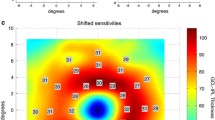Abstract
Background
Contrast sensitivity (CS) has been studied extensively to determine its effectiveness as a test for diagnosing early and advanced diabetic retinopathy. Various techniques have been adopted to measure CS, and most of them reported a significant difference between diabetic and normal eyes. Our purpose is to demonstrate differences in foveal CS between diabetic patients without retinopathy and healthy subjects under mesopic and photopic conditions, using a simple, rapid computerized test.
Methods
Seventeen eyes of nine patients with type 2 diabetes without diabetic retinopathy were included. Fourteen eyes of seven non-diabetic patients served as controls. All the patients underwent a careful ophthalmologic examination, including ETDRS chart visual acuity, color photographs, and optical coherence tomography (OCT). Patients with any ocular disease were excluded. All eyes had a visual acuity of 20/25 or better, a normal eye examination and optical coherence tomography (OCT). Photopic and mesopic contrast sensitivity was tested using a computerized psychophysical static method involving four forced-choice procedures. The targets were Gabor patches with spatial frequencies of 3–12 cycles per degree (cpd). The mesopic testing was conducted in a completely darkened room; the monitor was covered with a neutral density filter, allowing luminance of only 0.9 cd/m2.
Results
The average age was similar: 59.1 ± 5.3 years in the diabetic group vs 61.4 ± 3.2 years in the control group. The average duration of diabetes was 16 years (range 6–26). The average visual acuity was 0.04 ± 0.01 logMAR and 0.01 ± 0.01 logMAR in the diabetic and control groups respectively. Photopic foveal CS was similar in both groups. Significantly lower CS was found in diabetic patients under mesopic conditions at a spatial frequency of 3 (p < 0.008). At higher spatial frequencies, the mesopic contrast sensitivity was very low in both groups and without a significant difference.
Conclusions
Mesopic foveal CS is impaired in diabetic patients despite good visual acuity, a normal fundus examination and normal OCT. Early central visual function impairment may occur in diabetic patients before the appearance of retinopathy.



Similar content being viewed by others
References
Moloney J, Drury MI (1982) Retinopathy and retinal function in insulin-dependent diabetes mellitus. Br J Ophthalmol 66(12):759–761
Hyvärinen L, Laurinen P, Rovamo J (1983) Contrast sensitivity in evaluation of visual impairment due to diabetes. Acta Ophthalmol (Copenh) 61(1):94–101
Abrishami M, Heravian J, Derakhshan A, Mousavi M, Banaee T, Daneshvar R, Moghaddam HO (2007) Abnormal Cambridge low-contrast grating sensitivity results associated with diabetic retinopathy as a potential screening tool. East Mediterr Health J 13(4):810–818
Arend O, Remky A, Evans D, Stüber R, Harris A (1997) Contrast sensitivity loss is coupled with capillary dropout in patients with diabetes. Invest Ophthalmol Vis Sci 38(9):1819–1824
Khosla PK, Talwar D, Tewari HK (1991) Contrast sensitivity changes in background diabetic retinopathy. Can J Ophthalmol 26(1):7–11
Brinchmann-Hansen O, Bangstad HJ, Hultgren S, Fletcher R, Dahl-Jørgensen K, Hanssen KF, Sandvik L (1993) Psychophysical visual function, retinopathy, and glycemic control in insulin-dependent diabetics with normal visual acuity. Acta Ophthalmol (Copenh) 71(2):230–237
Verrotti A, Lobefalo L, Petitti MT, Mastropasqua L, Morgese G, Chiarelli F, Gallenga PE (1998) Relationship between contrast sensitivity and metabolic control in diabetics with and without retinopathy. Ann Med 30(4):369–374
Dosso AA, Bonvin ER, Morel Y, Golay A, Assal JP, Leuenberger PM (1996) Risk factors associated with contrast sensitivity loss in diabetic patients. Graefes Arch Clin Exp Ophthalmol 234(5):300–305
Bangstad HJ, Brinchmann-Hansen O, Hultgren S, Dahl-Jørgensen K, Hanssen KF (1994) Impaired contrast sensitivity in adolescents and young type 1 (insulin-dependent) diabetic patients with microalbuminuria. Acta Ophthalmol (Copenh) 72(6):668–673
Talwar D, Sharma N, Pai A, Azad RV, Kohli A, Virdi PS (2001) Contrast sensitivity following focal laser photocoagulation in clinically significant macular oedema due to diabetic retinopathy. Clin Experiment Ophthalmol 29(1):17–21
Khosla PK, Rao V, Tewari HK, Kumar A (1994) Contrast sensitivity in diabetic retinopathy after panretinal photocoagulation. Ophthalmic Surg 25(8):516–520
Malukiewicz G, Lesiewska-Junk H, Kaźmierczak K (2009) Changes in the colour vision and contrast sensitivity in diabetic patients without retinopathy. Klin Oczna 111(7–9):221–223
Liska V, Dostálek M (1999) Are contrast sensitivity functions impaired in insulin dependent diabetics without diabetic retinopathy? Acta Medica (Hradec Kralove) 42(4):133–138
Krasny J, Andel M, Brunnerova R, Cihelkova I, Dominek Z, Lebl J, Papadopoulos K, Soucek P, Treslova L (2007) The contrast sensitivity test in early detection of ocular changes in the relation to the type I diabetes mellitus compensation in children, teenagers, and young adults. Recent Pat Inflamm Allergy Drug Discov 1(3):232–236
Dosso AA, Yenice-Ustun F, Sommerhalder J, Golay A, Morel Y, Leuenberger PM (1998) Contrast sensitivity in obese dyslipidemic patients with insulin resistance. Arch Ophthalmol 116(10):1316–1320
Benedek G, Benedek K, Kéri S, Janáky M (2003) The scotopic low-frequency spatial contrast sensitivity develops in children between the ages of 5 and 14 years. Neurosci Lett 345:161–164
Benedek G, Benedek K, Kéri S, Letoha T, Janáky M (2003) Human scotopic spatiotemporal sensitivity: a comparison of psychophysical and electrophysiological data. Doc Ophthalmol 106:201–207
Fiorentini A, Pirchio M, Spinelli D (1980) Scotopic contrast sensitivity in infants evaluated by evoked potentials. Invest Ophthalmol Vis Sci 19(8):950–955
Levitt H (1971) Transformed up-down methods in psychoacoustics. J Acoust Soc Am 49(Suppl 2):467–477
Mäntyjärvi M, Laitinen T (2001) Normal values for the Pelli–Robson contrast sensitivity test. J Cataract Refract Surg 27(2):261–266
Karadeniz S, Kir N, Yilmaz MT, Ongör E, Dinççag N, Başar D, Akarçay K, Satman I, Devrim AS (1996) Alteration of visual function in impaired glucose tolerance. Eur J Ophthalmol 6(1):59–62
Lopes de Faria JM, Katsumi O, Cagliero E, Nathan D, Hirose T (2001) Neurovisual abnormalities preceding the retinopathy in patients with long-term type 1 diabetes mellitus. Graefes Arch Clin Exp Ophthalmol 239(9):643–648
Author information
Authors and Affiliations
Corresponding author
Additional information
Proprietary interest
None
Financial disclosure
None
Rights and permissions
About this article
Cite this article
Katz, G., Levkovitch-Verbin, H., Treister, G. et al. Mesopic foveal contrast sensitivity is impaired in diabetic patients without retinopathy. Graefes Arch Clin Exp Ophthalmol 248, 1699–1703 (2010). https://doi.org/10.1007/s00417-010-1413-y
Received:
Revised:
Accepted:
Published:
Issue Date:
DOI: https://doi.org/10.1007/s00417-010-1413-y




